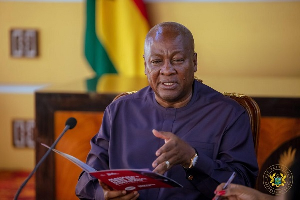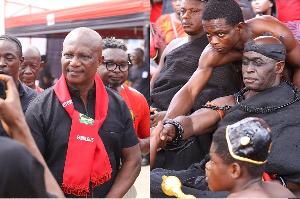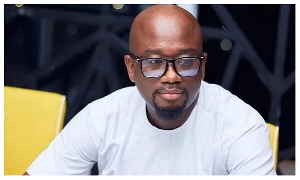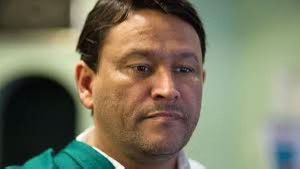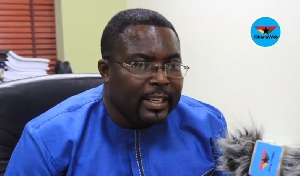ON A SULTRY mid-Thursday afternoon of Thursday stands a lady, almost nude, throwing water on her body. A group of young men sit idle meters away from her, chatting and puffing marijuana. Not far from her and just by a ramshackle that passes as a place of convenience besides a huge pile of refuse dump, two young men stick their knives into the carcass of a slaughtered sheep. Bloodstained cotton pads lie not far from the slaughter slab.
This is an example of the daily activities of Ghana’s version of the Biblical Sodom and Gomorrah, a settlement of over 23,000 people (according to the last census report), which lies by the bank of the dead Korle lagoon now undergoing a $67 million reclamation exercise.
“Sex is nothing here; rape is normal. Few things surprise few people. Sleeping outside in the night is an invitation for a predator to strike. Most of us sleep with tight protective underwear – especially tight worn-out jeans on because you could wake up in the middle of the night to find somebody crawling on you to do his own thing,” Mumuna Seidu, a porter at the Agbogboloshie Market, recalls.
Amina Halittu from Lawra, a resident and a hired hand at one of the numerous retailing shops at the Makola Market, Accra, recounts an experience where she woke up in the middle of the night to see a man trying to rape her. She believes she was lucky he did not succeed. She would not have had the energy and willingness to report to the police, she said.
Truth is, there is an ‘inner city’ law that operates. Avoid, where possible, in drawing the focus of the police on activities here, is the cardinal principle members of the community live by. It’s treachery to attempt to do anything outside this and it could result in life-threatening situations.
Police sources say out of the number of suspected criminals arrested in the police and army swoop at Sodom and Gomorrah last month, a number of criminals were identified. Twenty-four of the suspects were later identified as armed robbers. Others were found with “wee” and cocaine when searched, sources say. Several instances exist where wanted criminals, including murderers wanted by the police have been arrested in Sodom and Gomorrah.
Life here is the survival of the fittest. It’s unlike anywhere else. In short, the community, born barely 10 years ago, has emerged as an albatross, with its attendant cases of social vices.
Lying few kilometres from the main business district of Accra, Sodom and Gomorrah has always put a temporary halt to the construction of the Korle Lagoon Recreational project. And despite recent directives from the Minister of Local Government and Rural Development, Kwadwo Baah-Wiredu, and Deputy Minister of Works and Housing, Theresa Tagoe, to members of the settlement to move out to pave way for the project to go on, the situation remains the same.
The original residents of this area officially known as Korle Dudor or Old Fadama, which stretches from the Korle-Lagoon to the Mosque at Abossey Okai, were resettled at New Fadama, near Abeka, by the Nkrumah administration. The area was then earmarked for a Korle lagoon Recreational Facility. After the overthrow of Nkrumah in the 1966 coup, the place was left to fallow.
After a clash of Kokomba and Nanumba traders at the Yam market ain Accra in 1980, the Limann administration, sources say, decided to temporary rehabilitate the Kokomba faction at Old Fadama (present day Sodom and Gomorrah) to pave way for government to look for a place to resettle them. Later, a group of Nzema coconut oil sellers and Kwahu Russia second-hand cloth sellers joined the Kokombas as temporary settlers of the land.
It was then still known as Old Fadama. Until Mr. Kofi Portuphy, immediate past chairman of the National Disaster Mobilisation Organisation (NADMO) and one-time Chief Executive of the Accra City Council (ACC), now renamed the Accra Metropolitan Assembly (AMA), assumed the city’s mayoral chair after the dismissal from office of the then chief executive, Mr. E. T. Mensah in 1992.
It was gathered from various sources that on the eve of the 1992 Non-Alligned Movement (NAM) conference in Ghana, Portuphy, then the new AMA boss, asked the street hawkers along the pavements of Accra to relocate to New Fadama to give the city a beautiful facelift during the period of the conference. After persistent pressure, the hawkers moved in.
Dr. J. Bart-Plange, the private medical practitioner who owns and operates the only health facility in the community, and Mr. E. T. Mensah, ex-Youth and Sport Minister and one-time Chief Executive of AMA, as well as a number of the original settlers of Sodom and Gomorrah believe that this is the genesis of the current problem.
According to Dr. Bart-Plange, by the time the conference ended and the hawkers moved back onto the streets, a new wave of settlement had began with every homeless person relocating to Old Fadama.
After they started pushing the frontiers towards the lagoon, he said he warned the new settlers of the consequences of their action.
“I told them that like Sodom and Gomorrah, what they were doing by building close to the lagoon would end in the destruction of the place one day, and that they should know that there is a permanent plan in place for the area.”
Hence, the emergence of the name Sodom and Gomorrah. But just as names have meaning, the people of the area have been living up to the meaning of the Biblical namesake.
In 1994 Kokomba-Nanumba conflict worsened the situation as large droves of people flocked from the conflict area into Sodom and Gomorrah, pushing its frontiers further. Today, it remains one of the biggest problems facing the national capital.
At a glance from the main Agbogboloshie street of Accra, all seem too well with the area pointing to Sodom and Gomorrah. Shops by the streets give a reflection of a normal market centre that exists in other communities. Beyond the imagery, however, lie the real Sodom and Gomorrah. ‘It’s a blot on the national psyche that we have a community like this. And instead of resolving its problems or resettling them, we decided to resettle Liberian refugees,” Dr. Bart-Plange said, referring to the resettlement of Liberian refugees by the UN and Ghana at Buduburam.
But Sodom and Gomorrah, according to Aryeh Datey, Chief Executive Officer of the Ashiedu Keteke Sub-Metro Council of the AMA, is an illegal settlement.
He said the AMA has never issued permits for building to any of the residents because the land area is a government property over which they have no authority.
Incidentally, a number of residents of this illegal settlement claim they pay property rates, as well as other forms of taxes to the state through the metro district council every year. But while Datey admitted that the AMA collects business rates from shop owners along the main Agbogbloshie side of Sodom and Gomorrah, he says his office does so because ‘they engage in business activities and we need the revenue.”
But many residents disagree. Some insist that they are legitimate settlers and should be separated from those close to the Korle Lagoon in the area, who they the residents themselves refer to as ‘the real squatters.”
He believes the collection does not give legal title or claim to any of the people in the area and that all the residents are squatters.
“We pay for water, we pay for electricity (and) we pay property rates and many other things. How come they take our money but deny us the right to exist here,” asked Opoku Frimpong, another resident.
Though the area has electricity, water, phones and even communication centres, the environmental and sanitation situation is best seen than described.
The area has a high rate of infection of communicable diseases, according to the AMA sub-metro chief. He said the deplorable environmental status of the area had led to a high concentration of serious communicable diseases in Ghana at the Ashiedu Keteke district.
He said the number of cholera cases recorded in the district per year is alarming, adding that because of these problems the district always has its name high on the lists of districts with serious health related diseases attributable to unsanitary conditions.
According to Dr. Bart-Plange, everybody in the area was made to understand that they were temporary settlers before they settled. He, however, believes that the government must resettle those it promised to resettle.
Messrs De-graft Johnston and Alfred Y. Adjepong, Chairman and Secretary respectively of one of the original settlers organisations, the Obroni Wawu (Second-hand cloths) Sellers Association, also noted in separate interviews that they were made to understand that they were temporary residents of the area pending resettlement.
Both men, however, argue that since the area has already developed, the only way out is for government to provide the necessary amenities to lift the place up and allow the residents to stay.
But the solution to the situation, many agree, lies in the political will of the Kufuor administration to implement the decision to move the residents out.
According to E. T. Mensah, what is needed to solve the situation at Sodom and Gomorrah is the political will. “The government needs the political will to deal with the situation because there is no way we can have what we have now where it is,” he said.
He noted that Sodom and Gomorrah should not have been where it is. “There is no reason for it to be where it is today.”
E. T. Mensah, who was the chief of the capital’s metro organisation for a long time, noted that the Korle Lagoon recreation project had been on the drawing board since independence and every person living in the area had been made to understand that he was a temporary squatter.
According to him, there is no reason why the Korle Lagoon Recreational project should not go on.
The Chairman of the Ashiedu Keteke Sub-Metro District Council, Aryeh Datey, in a separate interview also expressed similar sentiments. “What is needed, and has been needed to solve this issue all this while, is the political will,” he said.
He added: “Politicians, unfortunately, do not think like us civil servants. They more or less look at the votes and act, and that has been the problem at Sodom and Gomorrah.” He said such political calculations rendered the past NDC government incapable of resolving the problem.
“But I believe if it is done, the government stands to benefit more than they could lose,” he argued. “The project itself would provide employment to the teeming number of unemployed youth here and revive the economy of this place. For now, the political will is needed and we hope the NPP would provide that. As of now, it’s clear they must go,” Datey stressed.
This story first appeared in The Nation, a weekly newsmagazine then edited by Alfred Ogbamey early this year.






